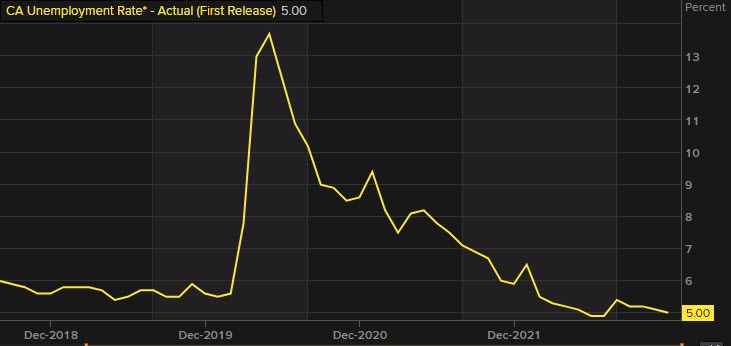
- Prior report 10.1 K
- Employment change 104.0K vs 8.0K estimate
- Unemployment rate 5.0% versus 5.2% expected. Prior month 5.1%
- Full-time employment 84.5K versus 50.7K last month
- Part-time employment 19.5K versus -40.6Klast month
- participation rate 65.0% versus 64.8% last month
- average hourly wages 5.2% versus 5.4% last month
- record high employment rate for core aged women with 81% employed which is the highest rate since 1976 and 1.3% above the high seen in 2019
- full-time employment rose for the third consecutive month
- year-over-year, full-time employment was up 401,000. That accounts for all of the employment change over the year which totaled 394,000.
- Private sector jobs rose by 112,000. This was the largest increase since February 2022. Year on year private sector jobs increased by 325,000 (up 2.6%)
- public-sector and number of self-employed workers were little changed in December
- the unemployment rate declined for the third time in four months and left the rate just above the record low of 4.9% reached in June and July
- construction jobs rose +35,000
- transportation and warehousing increase +29,000
- information, culture and recreation +25,000
- healthcare -17,000
For the full report CLICK HERE.
The data is hot, hot, hot, and puts the Bank of Canada in a predicament. The rise in the rates in Canada has already put intense pressure on the mortgage market and payments made by home owners as they reset over time.
With the expectations that the BOC may have to continue its tightening policy to curb inflation, it is also heading toward a car crash as consumers are faced with mortgage payments that take money away from all other discretionary and even non-discretionary consumption.
Ultimately, it should end in tears, with unemployment moving higher and price pressures abating. However, right now, the cycles are not in synch.
The USDCAD was trading at 1.3653 just before the US and Canada jobs reports. The price has moved own to a low immediately after the report to 1.3589. It is currently trading at 1.3609. The 100 and 200 hour moving averages are down at 1.3572 and 1.3560 respectively. Stay above is more bullish. Move below is more bearish
The price of the USDCAD has seen up and down swings this week with the high on Tuesday at 1.36845, and the low in the Asian session yesterday just above the rising 100 day moving average. The low price reached 1.34694. The 100 day moving average is currently at 1.3469.
Ahead of the report, Dow Industrial Average -10 points. S&P index -7 point. NASDAQ -49 points. US stocks are moving higher with the Dow up 151 points. The S&P index up 17 points and the NASDAQ index up 34 points.



